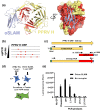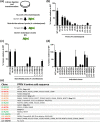Application of error-prone PCR to functionally probe the morbillivirus Haemagglutinin protein
- PMID: 33739251
- PMCID: PMC8290269
- DOI: 10.1099/jgv.0.001580
Application of error-prone PCR to functionally probe the morbillivirus Haemagglutinin protein
Abstract
The enveloped morbilliviruses utilise conserved proteinaceous receptors to enter host cells: SLAMF1 or Nectin-4. Receptor binding is initiated by the viral attachment protein Haemagglutinin (H), with the viral Fusion protein (F) driving membrane fusion. Crystal structures of the prototypic morbillivirus measles virus H with either SLAMF1 or Nectin-4 are available and have served as the basis for improved understanding of this interaction. However, whether these interactions remain conserved throughout the morbillivirus genus requires further characterisation. Using a random mutagenesis approach, based on error-prone PCR, we targeted the putative receptor binding site for SLAMF1 interaction on peste des petits ruminants virus (PPRV) H, identifying mutations that inhibited virus-induced cell-cell fusion. These data, combined with structural modelling of the PPRV H and ovine SLAMF1 interaction, indicate this region is functionally conserved across all morbilliviruses. Error-prone PCR provides a powerful tool for functionally characterising functional domains within viral proteins.
Keywords: directed evolution; epPCR; morbillivirus; peste des petits ruminants virus; viral entry; viral evolution.
Conflict of interest statement
The authors declare that there are no conflicts of interest.
Figures



Similar articles
-
Structure-Guided Identification of a Nonhuman Morbillivirus with Zoonotic Potential.J Virol. 2018 Nov 12;92(23):e01248-18. doi: 10.1128/JVI.01248-18. Print 2018 Dec 1. J Virol. 2018. PMID: 30232185 Free PMC article.
-
Productive replication of peste des petits ruminants virus Nigeria 75/1 vaccine strain in vero cells correlates with inefficiency of maturation of the viral fusion protein.Virus Res. 2019 Aug;269:197634. doi: 10.1016/j.virusres.2019.05.012. Epub 2019 May 23. Virus Res. 2019. PMID: 31129173
-
Identification of amino acid residues involved in the interaction between peste-des-petits-ruminants virus haemagglutinin protein and cellular receptors.J Gen Virol. 2020 Mar;101(3):242-251. doi: 10.1099/jgv.0.001368. Epub 2019 Dec 18. J Gen Virol. 2020. PMID: 31859612 Free PMC article.
-
[Entry mechanism of morbillivirus family].Yakugaku Zasshi. 2013;133(5):549-59. doi: 10.1248/yakushi.13-00001-5. Yakugaku Zasshi. 2013. PMID: 23649396 Review. Japanese.
-
Host Cellular Receptors for the Peste des Petits Ruminant Virus.Viruses. 2019 Aug 8;11(8):729. doi: 10.3390/v11080729. Viruses. 2019. PMID: 31398809 Free PMC article. Review.
Cited by
-
Arboviruses: the hidden danger of the tropics.Arch Virol. 2025 May 26;170(7):140. doi: 10.1007/s00705-025-06314-5. Arch Virol. 2025. PMID: 40418376 Review.
-
Deep mutational scanning and CRISPR-engineered viruses: tools for evolutionary and functional genomics studies.mSphere. 2025 May 27;10(5):e0050824. doi: 10.1128/msphere.00508-24. Epub 2025 Apr 24. mSphere. 2025. PMID: 40272173 Free PMC article. Review.
-
Molecular epidemiology of peste des petits ruminants virus emergence in critically endangered Mongolian saiga antelope and other wild ungulates.Virus Evol. 2021 Jun 25;7(2):veab062. doi: 10.1093/ve/veab062. eCollection 2021. Virus Evol. 2021. PMID: 34754511 Free PMC article.
References
Publication types
MeSH terms
Substances
Grants and funding
- BBS/E/I/00007034/BB_/Biotechnology and Biological Sciences Research Council/United Kingdom
- MC_UU_12014/10/MRC_/Medical Research Council/United Kingdom
- BBS/E/I/00007039/BB_/Biotechnology and Biological Sciences Research Council/United Kingdom
- WT_/Wellcome Trust/United Kingdom
- BBS/E/I/00007030/BB_/Biotechnology and Biological Sciences Research Council/United Kingdom
LinkOut - more resources
Full Text Sources
Other Literature Sources

